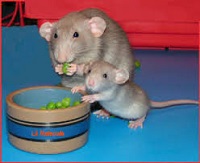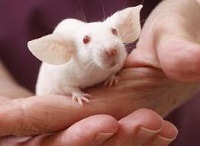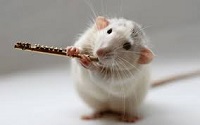Fancy Rat Facts
The term Fancy Rat comes from the phrase ˝to fancy˝ meaning to like or
appreciate. They have been specially bred as pets since the 18th century. Stores and
breeders commonly sell them as pets today. Fancy rats have many interesting characteristics
such as:
Social Behavior

Rats are very social with other rats. It is better to keep them in pairs. Usually, a
pair of females is recommended for first time rat caretakers. Rats spend a lot of time
grooming each other and sleeping together when kept in groups. One rat will be dominant
and the others will have their own place in the pack. They tend to ˝play
fight˝ with one another, but if living space becomes limited, they may turn more
aggressive. One may even kill the other to reduce the burden over the living space.
Rats also form family groups. Both males and females do this. But being territorial
animals they are wary or even scared of unfamiliar rats. They will puff up their fur,
hiss and squeal when defending their territory. Huddling is an important part of the
socialization of rats. It is thought to be a heat conserving function and baby rats
depend on heat from their mother as they are born without hair and cannot control
their own body heat. Other interactions include crawling under or walking over and
there is allo‐grooming which is different from self‐grooming and a type
of contact of contact called nosing. This involves one rat gently pushing another
rat with its nose near the neck.
Return to top.
Description

With an average life‐span of two to three years, the average rat is between
9 and 11 inches long with a tail length of 7 to 9 inches. They are easily tamed and
relatively easy to care for but are not low‐maintenance pets. Their coats come
in a variety of different colors and markings. Some rats retain the so‐called
˝Agouti˝ markings meaning that there are three tones of color on the same
hair. Others have a single color on each hair giving them a solid appearance. These
˝black˝ colors include black, beige, and chocolate.
Eye color is also considered a subset of coloring as many of the genes that control
coat coloring also control eye coloring. The American Fancy Rat and Mouse Association
(AFMRA) defines black, pink, ruby and odd‐eyed as possible eye colors
depending on the variety of rat. Ruby refers to eyes that appear to be black but are
actually a deep, dark red color after closer examination. Coat color names can be
even more vague. Names standards like lilac and fawn can fluctuate between different
countries or even different clubs.
Markings further divide the variety of fancy rats. They typically describe the
patterns or ratios of colors to white hairs. A self is a completely solid
non‐white color while a Himalayan refers to a completely white rat with a
blending of coloring toward the feet and nose called ˝points˝ similar to
a Siamese cats markings. Commonly recognized markings include:
- Berkshire which is a colored top and white belly
- Hooded when the color runs from full head down the spine
- Capped where color is on the full head only
- Variegated which is a blaze or short white strip on the forehead, with a fully
colored head and speckles of flecks running down the back only
- Irish or English a variety in England with an equilateral triangle of white with
a side that begins on the chest or between the front legs and the point ends somewhere
mid‐length. The AFRMA and many clubs in the US define the English Irish as having
white of an even or symmetrical nature anywhere along its underside.
Rats also come in several body types and coat types. The Manx and Dumbo rats are two
of the most prominent manifestations of physical change to arise from selective breeding
programs and are not all internationally standardized. The Dumbo is characterized as
having large, low, round ears on the side of its head while the Manx gets its name from
the tailless Manx cat.
Coat types come in a limited varieties compared to color and again all are not
internationally standardized. The most common type of coat is Normal or
˝Standard ˝. This variety allows for more variance in coarseness between
the sexes. Other standardized coats include:
- Rex, in which all the hairs are curly and soft, even the whiskers
- Velveteen, which is an even softer variation of the Rex
- Satin or Silky coats which are soft and fine with a sheen
- Harley which is characterized by long, wispy , straight hairs
Hairless rats are characterized by varying amounts of hair loss. They are bred from
curly‐coated Rexes. With Rex being a dominant trait, it only takes one Rex parent
to produce Rex‐coated offspring. But when two copies of the trait are present,
it causes hairlessness and has earned the colloquial name ˝Double‐Rex˝.
Return to top.
Rat Personalities

If you take the time to get to know them, you will discover that rats have their
own distinct personalities, especially if you keep them in groups of two or more.
They can be acrobatic and energetic, snugly, or be an oddball or introvert.
The aptly‐named ˝acrobat˝ is normally more active than their
cohorts, especially when it comes to climbing, jumping flipping and swinging.
It is not unusual to find one of these characters hanging upside down from the
top of the cage.
˝Snugglers˝ love to run up the inside of your sleeve or sit in your hoodie
or even sit on your shoulder or neck, especially if you have long hair. They will sit
on your lap or cuddle against your leg and beg to be petted on their belly or scratched
on the head. They will run towards people when they enter a room, stand on their hind
legs when someone familiar approaches, or crawl all over you looking for that perfect,
comfy spot.
˝Oddballs˝ are unpredictable and entertaining. Sometimes they want to
cuddle, others times not at all. Food motivation determines whether they will play
a game or not, or even if they come out to greet you. They have bouts of neediness
but usually just do their thing. If your rat is moody with sudden bursts of energy
or enjoys chasing games but never the same game twice, you may have an
˝Oddball˝ on your hands.
Then there is the ˝Introvert˝. This type of rat will come to you when
they need attention and leave when they are done with you. They will often sleep at
the bottom of the rat pile. They do not always get excited when you open the cage
door. Sometimes they will not sleep in the rat pile at all. They love tunnels but
can be a bit lazy and this can lead to being a bit overweight, so you have to watch
their food intake.
Return to top.
Organizations
Here are some places on the web where you can find out information about your rat and some of the services they offer.
Return to top.


